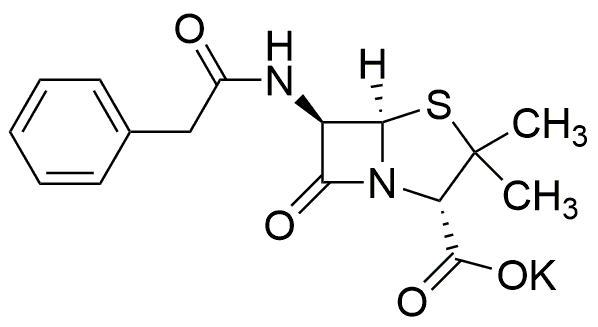Penicillin G potassium salt powder is widely utilized in research focused on:
- Antibiotic Therapy: This compound is primarily used to treat bacterial infections, particularly those caused by Gram-positive bacteria. Its effectiveness in combating infections such as pneumonia and strep throat makes it a staple in clinical settings.
- Pharmaceutical Formulations: It serves as a key ingredient in various pharmaceutical products, including injectable formulations. This allows for rapid absorption and effectiveness in treating acute infections.
- Veterinary Medicine: The compound is also employed in veterinary practices to treat infections in animals, ensuring their health and well-being, especially in livestock.
- Research Applications: In microbiology and pharmacology research, it is used to study bacterial resistance and the mechanisms of action of antibiotics, providing valuable insights for developing new treatments.
- Quality Control in Manufacturing: The compound is utilized in quality control processes to ensure the potency and purity of antibiotic products, helping manufacturers meet regulatory standards.
Información general
Propiedades
Seguridad y normativas
Aplicaciones
Penicillin G potassium salt powder is widely utilized in research focused on:
- Antibiotic Therapy: This compound is primarily used to treat bacterial infections, particularly those caused by Gram-positive bacteria. Its effectiveness in combating infections such as pneumonia and strep throat makes it a staple in clinical settings.
- Pharmaceutical Formulations: It serves as a key ingredient in various pharmaceutical products, including injectable formulations. This allows for rapid absorption and effectiveness in treating acute infections.
- Veterinary Medicine: The compound is also employed in veterinary practices to treat infections in animals, ensuring their health and well-being, especially in livestock.
- Research Applications: In microbiology and pharmacology research, it is used to study bacterial resistance and the mechanisms of action of antibiotics, providing valuable insights for developing new treatments.
- Quality Control in Manufacturing: The compound is utilized in quality control processes to ensure the potency and purity of antibiotic products, helping manufacturers meet regulatory standards.
Documentos
Hojas de datos de seguridad (HDS)
La SDS proporciona información de seguridad completa sobre la manipulación, el almacenamiento y la eliminación del producto.
Especificación del producto (PS)
La PS proporciona un desglose completo de las propiedades del producto, incluida la composición química, el estado físico, la pureza y los requisitos de almacenamiento. También detalla los rangos de calidad aceptables y las aplicaciones previstas del producto.
Certificados de análisis (COA)
Busque certificados de análisis (COA) ingresando el número de lote del producto. Los números de lote y de partida se pueden encontrar en la etiqueta de un producto después de las palabras "Lote" o "Lote".
Número de catálogo
Número de lote/lote
Certificados de origen (COO)
Este certificado de origen confirma el país en el que se fabricó el producto y también detalla los materiales y componentes utilizados en él y si se deriva de fuentes naturales, sintéticas u otras fuentes específicas. Este certificado puede ser necesario para cumplir con las normativas aduaneras, comerciales y regulatorias.
Número de catálogo
Número de lote/lote
Hojas de datos de seguridad (HDS)
La SDS proporciona información de seguridad completa sobre la manipulación, el almacenamiento y la eliminación del producto.
DownloadEspecificación del producto (PS)
La PS proporciona un desglose completo de las propiedades del producto, incluida la composición química, el estado físico, la pureza y los requisitos de almacenamiento. También detalla los rangos de calidad aceptables y las aplicaciones previstas del producto.
DownloadCertificados de análisis (COA)
Busque certificados de análisis (COA) ingresando el número de lote del producto. Los números de lote y de partida se pueden encontrar en la etiqueta de un producto después de las palabras "Lote" o "Lote".
Número de catálogo
Número de lote/lote
Certificados de origen (COO)
Este certificado de origen confirma el país en el que se fabricó el producto y también detalla los materiales y componentes utilizados en él y si se deriva de fuentes naturales, sintéticas u otras fuentes específicas. Este certificado puede ser necesario para cumplir con las normativas aduaneras, comerciales y regulatorias.


